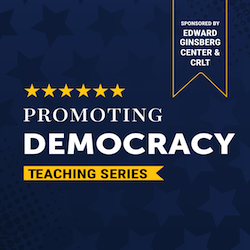 In a recent blog post, we addressed challenges and opportunities in returning to the classroom in the days immediately following an extremely divisive election. Here, we want to provide resources for teaching in the post-election climate over the longer term. No matter their political perspective, instructors are likely to notice that their students' learning or their classroom dynamics have been affected by the big emotions swirling around the new administration.
In a recent blog post, we addressed challenges and opportunities in returning to the classroom in the days immediately following an extremely divisive election. Here, we want to provide resources for teaching in the post-election climate over the longer term. No matter their political perspective, instructors are likely to notice that their students' learning or their classroom dynamics have been affected by the big emotions swirling around the new administration.
We have assembled some guidance in response to relevant questions and concerns we have been hearing from instructors in recent days. The following topics are looming large for many.
Establishing the boundaries of civil discourse in your classroom
Many CRLT resources emphasize the usefulness of establishing and reviewing discussion guidelines in order to foster a learning environment where multiple, often conflicting, perspectives can productively be shared and discussed. We recently met with Jack Bernard of the U-M General Counsel’s office, who endorsed this practice and offered a legal clarification we found useful. As Bernard explained, the classroom is a particular kind of campus space where norms of discourse are established by the instructor for the purposes of learning: "While some University spaces, such as the Diag, are limited public forums, where the institution does not control or constrain much speech, classrooms are nonpublic forums, where the University and its instructors control the context for speech, including the speech of students. For instance, instructors can determine who 'has the floor' and may be speaking [or] when it is and is not appropriate to move from one topic to another. Instructors establish the norms for engagement in the course and can respond to conduct or speech that is disruptive, such as disrespectful, insensitive, or mean-spirited remarks."Many instructors have also found this FAQ sheet from the American Association of University Professorshelpful in providing information and frameworks for making decisions about what ideas to share in the classroom and how.
Supporting students in distress
Students across many different identity positions are feeling threatened in this time--regarding their personal safety, the integrity of their families, or their freedom from harassment. While many find it possible and even helpful to focus on their schoolwork in such a climate, many don’t. Some students are having trouble attending class or completing assignments or group projects for their courses. This blog on supporting students in distress provides ideas about responding compassionately while maintaining the boundaries of your instructor role. Ideas include pointing students to mental health resources as well as activating their campus support network, which might include students’ academic advisors as well as the Dean of Students office. If you have students who are experiencing distress based on concerns about their immigration or visa status in the wake of the recent Executive Order, you can make sure they are aware of U-M’s International Center as a resource; the Center has published this update with recommendations. It’s useful, too, to be familiar with U-M President Mark Schlissel’s statements about the University’s strong support for international and immigrant students and scholars.
Supporting students in responding to violence or threats
Unfortunately, given ongoing patterns of identity-based violence in the wake of the election, it’s probably wise to be ready to support students in responding to threats or incidents of violence based on their race, religion, ethnicity, gender identity, or other identities. As a teacher, you may be a key contact and point of connection to the institution for your students. You have an opportunity to make sure they are aware of steps they can take if they experience or witness threats, violence, or other identity-based crimes against their property or person. These include knowing that in any emergency they can call 9-1-1 to reach U-M police. Students can also reach out for support and advocacy to various student life offices, including Multiethnic Student Affairs (MESA) and the Spectrum Center. Guidance about what and how to report can be found on the University bias reporting website. It’s important to keep in mind that, for various reasons, students will have different levels of comfort accessing any given resource, so it’s useful to be ready to share information about a range of options. Moreover, your own compassion, advocacy, and flexibility can also be critical resources for students affected by violence toward or around them.
Responding to tensions in the classroom
Tensions that students experience outside the classroom are also likely to affect the ways they interact with their classmates. In particularly, many instructors are worried about new potential for conflict and even hostility to arise in their classrooms. Preparing for the unexpected, as this resource on ‘making the most of hot moments’ helps instructors to do, can be especially important for increasing both your skills and confidence if tensions do erupt. Even though the semester is well underway, instructors can intentionally foster rapport and community among students, through ice-breakers, small group work, and other interactive opportunities. It’s important to be sensitive when developing such community-building strategies to students’ need for emotional safety and allow some choice in how, and to what degree, they engage with their peers, especially in paired or small group activities.
Tending to your own self-care needs
Different members of our teaching community are doing different kinds of emotional labor in this time, depending on our own positionalities and the number of students and colleagues who perceive and depend upon us as allies. The following links are written primarily for instructors of color, but they can be useful for all instructors, either because they provide generalizable self-care strategies or because they can increase everyone’s appreciation for the disproportionate strain on some colleagues of supporting students in this challenging time.
- This blog by Kerry Ann Rockquemore offers concrete ideas, strategies, and language for maintaining boundaries with both colleagues and students that allow instructors to strike a healthy balance of meeting professional commitments and personal needs.
- This post by Emily Dreyfuss offers simple suggestions for your personal wellbeing, but also suggests the need to listen carefully and responsively to the needs of others.
- For those feeling guilty about taking care of themselves in these times, this post by Shanesha Brooks-Tatum provides a reminder that self-care can be a political and a subversive act rather than a selfish or individual need.
As always, CRLT consultants are available to consult with you about a wide range of issues in your teaching. Whether you want to plan a course, discussion, or assignment or think through how to respond to dynamics or a specific incident in your classroom, you can request a consultation through our website or call us at 734-764-0505.
Photo adapted from Joe Piette via flickr CC BY-NC 2.0- Log in to post comments
- 1421 views






